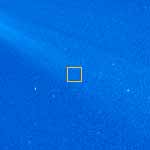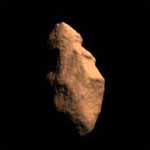| � |
Latest News
Events
Browse News
Search
|
Latest News
|
Is Pluto a planet? Astronomers meet in Prague to decide
16/08/06
|
�

|
|
Pluto was discovered in 1930 by American astronomer Clyde W Tombaugh and at the time it was thought to be large enough to be dubbed a planet. Over the last 76 years our understanding of the Solar System has improved dramatically, and we now know there could be dozens of Pluto-sized (or larger) objects orbiting in the outer Solar System.
The debate, which has been raging for years, came to a head with the discovery of 2003 UB313 � an object in the outer Solar System, slightly larger than Pluto.
Some scientists argue that Pluto�s planet status should remain for historical reasons, whereas others believe that we should use our improved knowledge of the Solar System�s formation to classify objects more systematically. There are several viewpoints about what the exact definition of the word �planet� should be, but the International Astronomical Union (IAU) have narrowed their choice down to three:
A planet is any object in orbit round the Sun with a diameter greater than 2000 kilometres. This would mean Pluto would remain a planet, but we would also gain 2003 UB313 as a planet � the Solar System would have ten planets!
A planet is any object in orbit round the Sun whose shape is stable due to its own gravity. This would allow many more objects to be classed as planets, but would exclude some larger objects with non-stable shapes, such as Pallas, in favour of other smaller objects.
A planet is any object in orbit round the Sun that is dominant in its immediate neighbourhood (this means the object has a mass greater than the sum of all the smaller objects in the same orbit). This would mean the Solar System would have eight planets because Pluto would be downgraded.
The IAU are due to announce their decision on Thursday.
More info: IAU
|
1000th �sungrazing� comet spotted by SOHO
14/08/06
|
�

|
|
Arkadiusz Kubczak, an amateur comet-hunter from Poland, recently discovered his third comet in images taken by SOHO. His latest discovery is interesting because it is classed as a Kreutz or sungrazing comet. These are comets that pass within around 146 thousand kilometres of the Sun � that�s a mere 0.01 per cent of the average Earth-Sun distance. This comet is particularly special as it marks the 1000th Kreutz comet to be found using data from the SOHO spacecraft.
When SOHO was launched in 1995, only around 30 Kreutz comets were known. Scientists think that these 1000-or-so fleeting comets were once part of a much larger comet, observed by Aristotle and Ephorus in around 371 BCE. The comet has since broken into fragments � so now many sungrazing comets can be seen.
This comet, officially designated C/2006 P7 (SOHO), was the 1185th to be discovered using data from the SOHO LASCO and SWAN instruments.
SOHO (the Solar and Heliospheric Observatory) is a NASA and European Space Agency (ESA) spacecraft designed to monitor the Sun, but can also be used to spot nearby comets, as the instruments block out the Sun�s glare. The LASCO (Large Angle and Spectrometric Coronagraph) and SWAN (Solar Wind Anisotropies) instruments were used to find the Kreutz comets, making SOHO the most successful comet-hunter ever.
More info: SOHO
|
Asteroid named after University of Leicester scientist
07/08/06
|
�

|
|
The International Astronomical Union has named an asteroid '4600 Meadows' to honour Professor Jack Meadows for his contribution to Astronomy research. Professor Meadows told us, �It is very pleasing because it particularly recognises the pioneering observations of minor bodies in the Solar System that my group made using the IUE (International Ultraviolet Explorer) and IRAS (Infrared Survey) satellites�.
Discovered in September 1985, Asteroid 4600 Meadows is about 25-30 kilometres in diameter and lies three times as far away from the Sun as the Earth. We asked Professor Meadows if this asteroid would be a threat to the Earth, �As I am sure you know, the asteroids in the asteroid belt are greatly affected by the gravitational effects of Jupiter. This means that predictions concerning asteroid orbits can only be extrapolated for a certain length of time into the future. The orbit of Asteroid 4600 does not intersect the Earth's orbit at present, but it cannot be said that it will never do so�.
After leaving the University of Leicester, Professor Meadows joined Loughborough University as Professor of Library and Information Studies. Professor Meadows joins Professor Ken Pounds as the second academic associated with the University of Leicester to have an Asteroid named after him.
More info: University of Leicester
|
Asteroid set for close encounter
02/07/06
|
�

|
|
Asteroid 2004 XP14 will pass Earth at a mere distance of 1.1 times the distance between the Earth and the Moon at 05:25 BST on Monday 3 July. According to NASA�s Jet Propulsion Laboratory (JPL), the asteroid is somewhere between 370 and 820 metres across.
"It's not Earth-threatening," said Don Yeomans, of NASA's Near Earth Object Program. "For something of this size to come this close is unusual."
Whilst the miss distance of around 432 308 kilometres is close in astronomical terms, astronomers have ruled out any possibility of it colliding with the Earth on Monday, or at any time in the next century. 2004 XP14 will make another close approach in 2019, and again in 2020, although neither will be as close as Monday�s pass.
The asteroid will pass through the constellations Perseus, Cassiopeia, Cepheus and Draco. It will have an apparent magnitude of +12 so it will only be visible with large telescopes.
2004 XP14 was spotted as part of the Lincoln Near-Earth Asteroid Research (LINEAR) project, with a telescope based in New Mexico, USA, in December 2004.
More info: JPL Near Earth Object Program
|
Itokawa asteroid is a loose pile of rubble
05/06/06
|
�

|
|
Recent data from the Japanese Hayabusa spacecraft suggests that the asteroid it visited at the end of last year, called Itokawa, is a loosely held pile of rubble. According to the craft�s survey the asteroid is still plagued by impacts and tremors, making scientists question how the pieces have managed to continue to cling together.
Before the mission, the Japanese Aerospace Exploration Agency (JAXA) had assumed that Itokawa must be one large piece of rock, as they thought such a small asteroid would have insufficient mass for its gravity to hold lots of smaller pieces together. The recent data has come as a surprise to the agency.
According to New Scientist Space, measurements of Itokowa�s gravity field suggest that 40 per cent of the asteroid is empty space. In comparison, a handful of sand is only around 20 per cent porous.
"That is astonishing," says Erik Asphaug, a planetary scientist at the University of California , USA. "It's very hard to get porosities greater than that. You've got to start balancing things delicately, like you were building a house of cards," he says. "The only way to do it is to gently pack the stuff together."
Images taken by Hayabusa showed the asteroid�s surface was littered with small pieces of rock. This suggests it was originally a larger, more solid asteroid that was broken up in a collision. The pieces were later pulled together by their own gravity, making the asteroid we see today. Usually such collisions pack down the rock pieces, making them less porous, so this finding has surprised scientists.
The 535 metre-long asteroid appears to have few impact craters. Scientists believe this is because each impact disturbs the gravel which then flows into the craters, hiding them from view.
Eros, a 33 kilometre-long asteroid, is the only other to have been studied in such detail. Eros was once one solid piece of rock that was then involved in a collision, shattering it into chucks. Although the rock was shattered, the pieces were held together in their previous positions under their own gravity.
JAXA have also announced that Hayabusa does have enough fuel left in its ion engines to make it back to Earth. Scientists were worried that the engines may have used up too much fuel for the return trip, after being used to control the craft�s orientation following a chemical fuel leak and the malfunction of one of the craft�s stabilisers. The craft was designed to collect samples from Itokawa and return them to Earth, but there is only a slight chance some material may have been knocked into the sample chamber during the sample collection attempts.
More info: New Scientist Space
Related News
Hayabusa probe approaches asteroid Itokawa
Hayabusa lander misses target
UK names to land on asteroid
First Hayabusa sample collection fails, but UK names are delivered to asteroid
Japanese announce that Hayabusa did land on Itokawa
Hayabusa collects asteroid sample
Hayabusa's return to Earth postponed until 2010
|
|
Goto to the news list
|
|
|
� NEO Information Centre
last updated on
25/09/06
Show the news panel
[email protected]
|

Operated by a consortium led by the
National Space Centre
|
|

